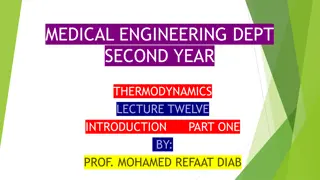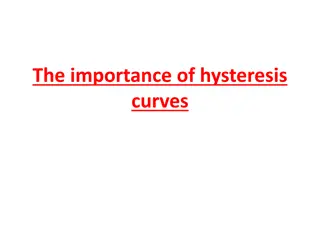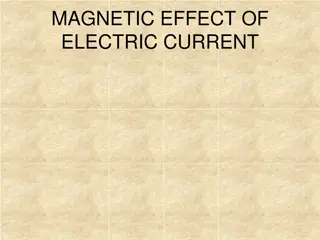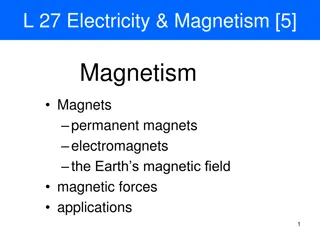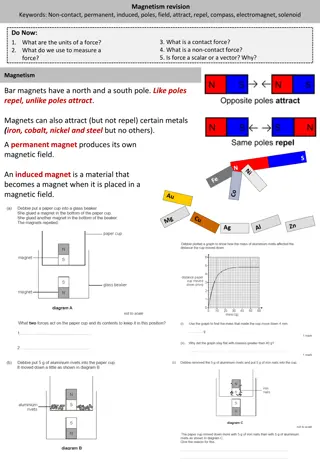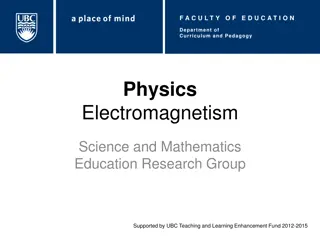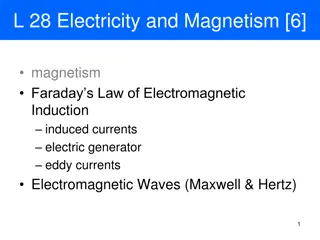Electromagnetism Exploration and Practical Applications
Delve into the fascinating world of electromagnetism with lessons covering magnetism basics, electromagnets, motors, transformers, and more. Students will learn about the principles of magnetism, electromagnet construction, testing methods, and how to increase electromagnet strength. Engage in hands-on activities and discussions to better understand the effects of current on magnetic fields and practical applications of electromagnets.
Download Presentation

Please find below an Image/Link to download the presentation.
The content on the website is provided AS IS for your information and personal use only. It may not be sold, licensed, or shared on other websites without obtaining consent from the author.If you encounter any issues during the download, it is possible that the publisher has removed the file from their server.
You are allowed to download the files provided on this website for personal or commercial use, subject to the condition that they are used lawfully. All files are the property of their respective owners.
The content on the website is provided AS IS for your information and personal use only. It may not be sold, licensed, or shared on other websites without obtaining consent from the author.
E N D
Presentation Transcript
L1 Introduction to magnetism L10 Loudspeakers & Microphones L2 Compasses L11 Transformers L3 EM practical L4 Solenoid L5 Force on a current carrying wire L6 Fleming LHR L7 Motors L8 Induced potential L9 Generator effect Lesson Sequence Pupils should have been taught to: Pupils will be taught: The basics on magnetism (attraction/repulsion, magnetic materials etc.) Electromagnetism in further detail (including force on current carrying wires/motor effects). Future Learning Specification Prior Learning
SciDoc Electromagnets practical Electromagnets practical Last Lesson Last Term Last Year Stretch & Challenge I do We do You do Do Now Test I do We do You do Do Now
SciDoc Electromagnets practical Electromagnets practical Keywords Learning Objectives Keywords Electromagnet Current Iron core Insulating Conductor Gradient Variable Recall that a current flowing through a wire creates a magnetic field. Describe the construction of an electromagnet. Describe how to test the strength of an electromagnet. I do We do You do Do Now Test I do We do You do Do Now
T/N: Electromagnets T/N: Electromagnets Any current flowing through a wire creates a magnetic field. This is called an electro-magnet. SciDoc Stretch: How would you turn an electromagnet on/off? I do We do You do LO: Test I do We do You do LO:
SciDoc I do We do You do LO: Test I do We do You do LO:
To increase strength of electromagnet: SciDoc T/N: Electromagnets T/N: Electromagnets Wind the wire so it has more loops. Stretch: Where is the magnetic field strongest/weakest? Increase the current in the wire. Add an iron core to the centre of the loops of wire. I do We do You do LO: Test I do We do You do LO:
SciDoc Label diagram and write prediction Label diagram and write prediction Stretch: What are the dangers of this practical? I do We do You do LO: Test I do We do You do LO:
SciDoc Draw results table Draw results table Number of coils Number of paperclips Stretch: Which column is the independent variable? 5 10 15 Which is the dependent variable? I do We do You do LO: Test I do We do You do LO:
SciDoc Rules of practical Rules of practical 1) You will be working in groups on the tables you usually work at. 2) Quiet discussion in your groups is encouraged but no shouting across the classroom. 3) Stay in your pairs; don t walk around the class. 4) Do not turn the power supply over 3 Volts. I do We do You do LO: Test I do We do You do LO:
SciDoc Method Method Set the power supply to 3V DC. Attach the wires as in the photo, listen to the demonstration so you know what s connected to where. Wrap firstly 5 coils around the nail (we will increase this later). Turn on the power supply. Increase the number of coils around the nail by 5 each time and record how many paper clips you can pick up. Stretch: Use the rheostat to investigate how current changes the strength of an electromagnet. I do We do You do LO: Test I do We do You do LO:
My results from My results from earlier earlier Number of coils Number of paperclips 4 7 11 SciDoc 5 10 15 20 25 30 35 40 15 19 23 22 30 I do We do You do LO: Test I do We do You do LO:
0 10 20 30 40 50 Graph Graph Plot a graph of number of paperclips (on the y axis) against the number of coils (on the x axis). Number of paperclips Remember to write a title. Stretch: Fit a straight line and calculate the gradient. 0 5 10 15 20 25 30 35 40 Number of coils
SciDoc Struggle time! Struggle time! Exam question so exam conditions! You have 6 minutes. I do We do You do LO: Test I do We do You do LO:
SciDoc I do We do You do LO: Test I do We do You do LO:
SciDoc How does a door lock work? How does a door lock work? I do We do You do LO: Test I do We do You do LO:
SciDoc Struggle time! Struggle time! Exam question so exam conditions! You have 4 minutes. I do We do You do LO: Test I do We do You do LO:
SciDoc I do We do You do LO: Test I do We do You do LO:





